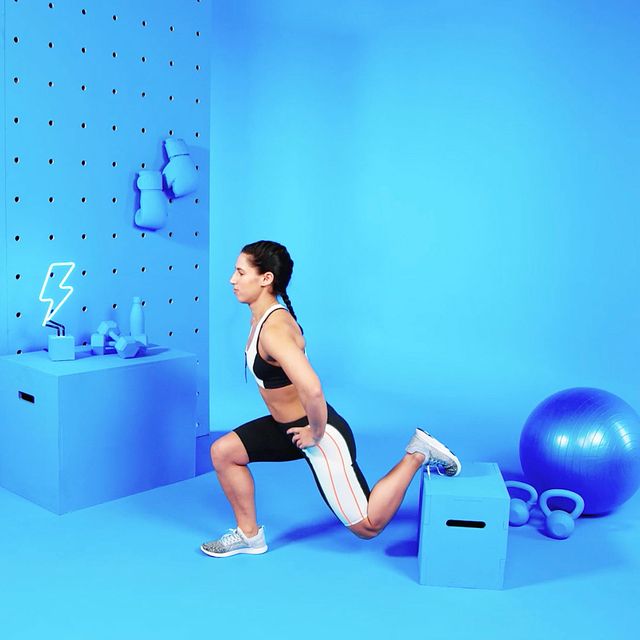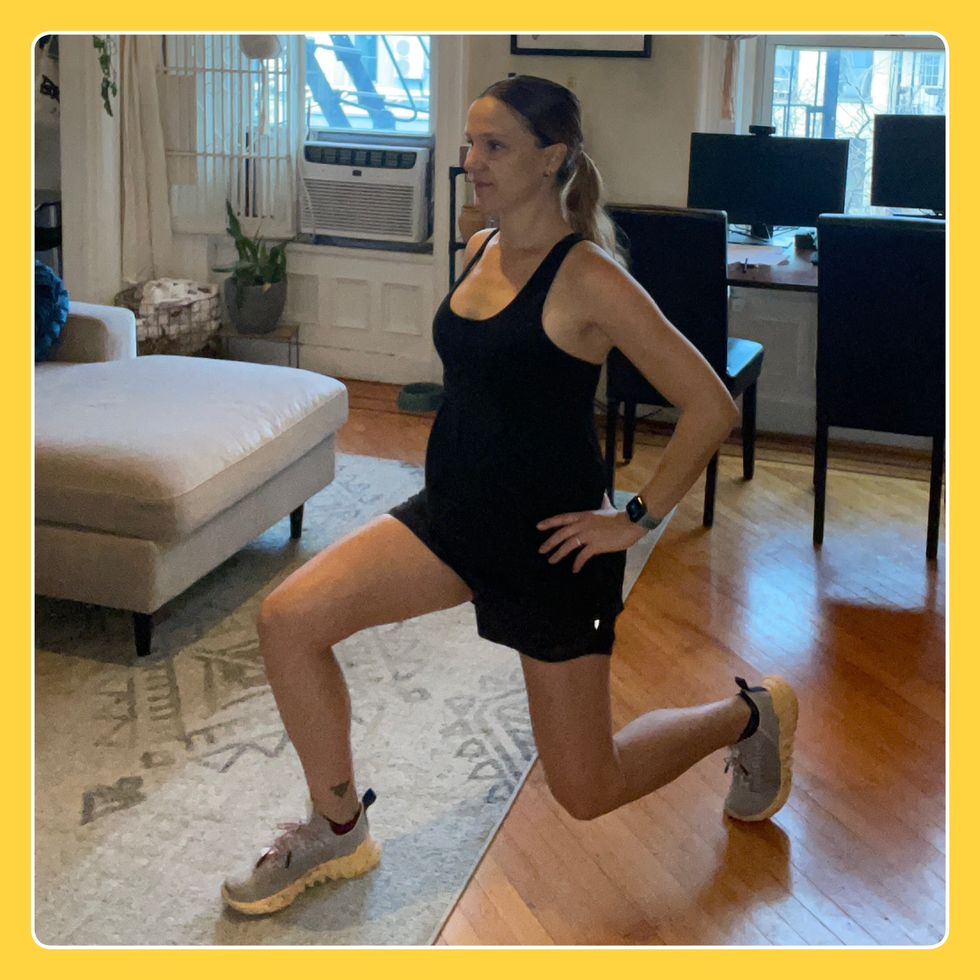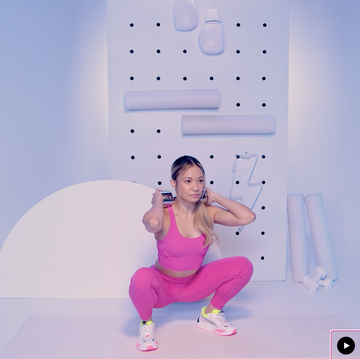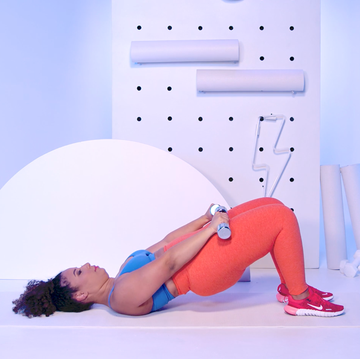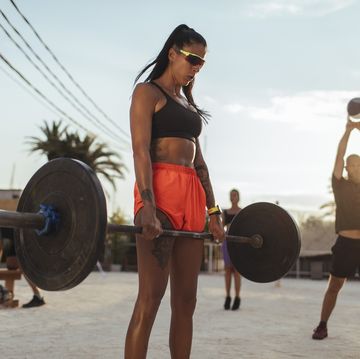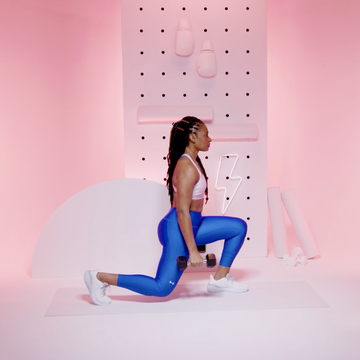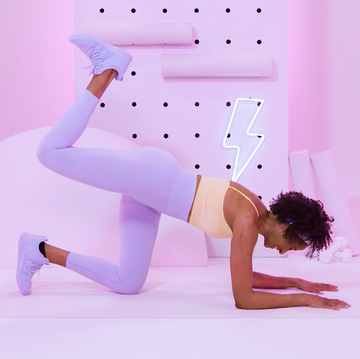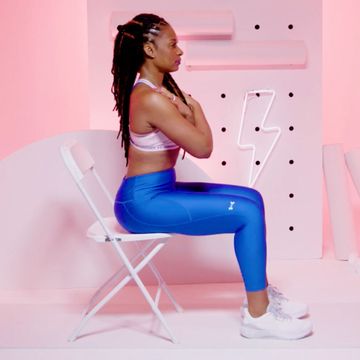If a Bulgarian split squat conjures an image of a Khal drogo-type flexing quads of steel, well, you’re not wrong. This intense lower-body isolation will light you up and build rock hard legs—but it’s also one of the best moves to correct imbalances and build functional, single-leg strength and power, says Harris Murrieta, CSCS, coach for personal training platform Ladder and director of recovery at Performix House in New York City.
And, it's totally doable for all levels. (Really!) A Bulgarian split squat is essentially a single-leg squat. Your back leg is elevated behind you on a steady box, chair, or bench, and your weight is loaded onto your front leg. It's a unilateral move that targets your quads, hamstrings, glutes, and calves. And since you're balancing on one leg, this move also stabilizes your pelvic floor, diaphragm, obliques, and the tiny muscles in your spine, says Kate Baird, ACSM certified exercise physiologist and member of the NYU Sports Performance Center team. (Yep, it's a sneaky core burner, too.)
The Bulgarian split squat is loaded with benefits, requiring balance, coordination, and strength. “Being able to hold your body weight up on one leg is super helpful for walking, running, jumping, sprinting, and changing directions,” says Baird. “You get a lot of bang for your buck."
What's more, working one leg at a time can help you recognize your weaknesses and identify any imbalances between sides. Here's everything you need to know, according to experts, to do the Bulgarian split squat with perfect form and add it to your workouts.
How To Do A Bulgarian Split Squat
- Stand in front of a low bench or platform with feet hip-width apart. Baird recommends a secure platform that is no higher than your knee.
- Place one foot onto the platform behind you, gently resting the top of the foot to stabilize. The distance between you and the elevated surface can vary depending on your experience and range of motion. “If your front heel is coming off the ground when you squat, you are probably too close,” says Baird. If this is the case, readjust and move your front foot slightly forward so it is directly below your knee when you reach the lowest point.
- Engage your core and glutes and lower down with control. Look straight ahead and keep your head and shoulders upright while evenly distributing your weight across your front foot. Baird recommends inhaling on the way down.
- Stop when your back knee hovers just off the ground. If your range of motion is limited, stop when you are as low as you feel comfortable.
- Drive through your front foot and squeeze your glutes as you stand back up. Stay centered over your front let and focus on your exhale while standing to trigger those core muscles. “Exhaling is what helps your obliques and abs engage,” says Baird.
Reps/sets for best results: This move will light up your lower body, even without weight, so aim for lower volume sets—four to five rounds of five to eight reps.
Benefits Of Bulgarian Split Squats
The Bulgarian split squat is a great lower-body strength exercise that primarily focuses on the quads and glutes. The biggest perk of this move, over others, is that it helps develop functional, single-leg strength and power.
“By putting somebody in a single-leg stance, you can identify weakness and strength in a more functional way than you could with symmetrical-stance squats or deadlifts,” Murrieta says.
That means whether you run races, play intramural soccer, or just want to to balance out your body, this move should be in your strength program.
Common Bulgarian Split Squat Mistakes
- Your back foot is too high. Incorrectly setting up the back leg is a super common mistake, says Baird. “People normally just grab whatever box is nearby and toss their foot up there.” Remember that the box, chair, or platform should be about knee height.
- You lose control. If you’re wobbling all over the place or falling, you want to take a step back and modify. Go for a lower platform and master your footing first. Practicing the move with an un-elevated split squat will mimic the movement and help train your muscles.
- You tuck your toes. Keep the top of your foot on the platform and do not tuck your toes. If the platform is hard and this is uncomfortable, place a towel as a cushion.
- Your hips open up. Your hips should always face forward, like headlights on a car. Don’t let the hip of your back leg open to the side. Keep your shoulders tall and refrain from leaning forward. Tracking your hips and shoulders straight ahead will target the correct muscles.
- You straighten your back leg. Make sure your back leg remains bent and your knee moves straight up and down. If your leg is straight, it will destabilize your motion and put unnecessary stress on it. Load your front leg muscles and use your back leg for balance.
Make Bulgarian Split Squats Part Of Your Workout
The best way to work it in: As one of the first moves on lower-body strength day, after a warm-up but before full-body fatigue exercises, Murrieta says. He prefers to combine it with other athletic training—footwork drills, running drills, plus isolated moves like pistol squats, single-leg hip thrusts, and single-leg deadlifts.
You can incorporate the move safely up to four to five times a week.
Bulgarian Split Squat Progressions To Try
TBH, the Bulgarian split squat is super hard as is, so start with both feet on the ground if you want to make it easier at first. Taking the balance aspect out of the equation will let you develop the foundational strength, Murrieta says.
Start with a small platform. Once you have mastered the range of motion with both feet on the ground, level up a bit. Baird suggests something that is halfway between the floor and your knee.
Grab some dumbbells. To make it more difficult, add some weight—dumbbells held at your sides, a kettlebell in front of your chest, or a barbell in a back rack position. But start light, Murrieta says—small weights add up fast for this move.
Power up with a jump. Still looking for more? You can spring-load your Bulgarian split squat to make it an advanced exercise that requires strength, balance, and coordination. It's challenging with only your body weight. Squat down as you normally would, and push through your front leg/foot to jump on the way up. “The Bulgarian split squat jump will help with power and speed,” says Baird.

Rachael Schultz is a freelance writer with years of experience covering health, nutrition, and physiology. In addition to Women's Health, she has written for Men's Health, Men's Journal, Cosmopolitan, SELF, and Weight Watchers, among other publications. She’s most passionate about hiking, traveling, mindfulness, cooking, and really, really good coffee.
